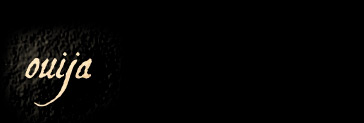 |
History | People | Boards | Stencils | Patents & Trademarks | Factories | Advertisements | Articles | Entertainment | Customer Letters | Other
Entertainment
Television | Movies | Plays | Sheet Music
The Ouija Board In Plays
Click any picture below to enlarge it and begin a photo gallery
*Your browser must allow popups to view the photo galleries
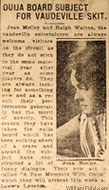 |
A Few Moments With
Ouija - 1921
|
A Few Moments With Ouija
Throughout 1921
“Jean McCoy and Ralph Walton, the vaudeville entertainers, are always welcome visitors on the circuit as they do not stick to the same material year after year as some players do. They are always looking for something new and and as a result their performance generally has the merit of novelty. This season they have taken the ouija board which has been nothing short of a craze and around the subject have constructed a lot of funny dialogue. Their new act is called “A Few Moments With Ouija” which they will present this week at Loew's Lyceum.” Their skit lasted fifteen minutes to a half an hour. Reviews at the time were kind, and its slapstick humor kept its audiences howling. Prices for the show were ten, twenty, and thirty cents in the evening. A matinee was twenty cents and children paid ten cents.
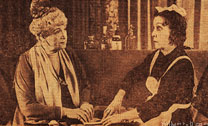 |
The Bat
1920, 1937, 1953 |
The Bat
August 23rd 1920, May 31st 1937, and January 20th 1953
The Bat was written by Mary Roberts Rinehart & Avery Hopwood. It was produced three times over the years. It first opened at the Morosco Theatre on August 23rd 1920 and ran until September of 1922. It was produced by Wagenhals and Collin Kemper. In its second revival it premiered at the Majestic Theatre where its run lasted from May 31st 1937 to June of 1937. It was produced by Ben Lundy and B. F. Kamsler. In its third and final production it opened at the National Theatre on January 20th 1953 and ran until February 7th 1953. It was produced by James Withers Elliott. This play took place in the living room, the library of a country house, and the trunk room on the third floor. This drama and made use of winding staircases, loud clapping thunder, and a bit of gore to keep its audiences on the edge of their seats through three acts. The Bat created a high level of anxiety and maintained it throughout until the very end. This was an effective tool that left its viewers worn out by the end of each performance. Reviews for each of these productions praised both the acting and the writing.
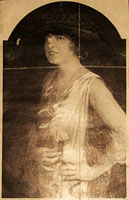 |
One
September 14th 1920 |
One
September 14th 1920
“One” was a metaphysical drama written by Edward Knoblauch and produced by David Belasco. It opened at the Belasco Theatre on September 14th and ran through December of 1920. In total it boasted one-hundred and eleven performances. “One” starred Lulu Ayrton as the an elevator girl, Randle Ayrton as Dr. Noah Petch, Theodore Babcock as Bert Mason, Delsie Belmore as Katie, Marie R. Burke as Mrs. Henry P. Howland, Philip Desborough as Theodore Beverly, Martin Lewis as Machael Jaffray, Clara Sidney as Mrs. Delgado, and Francis Starr as both Pearl Delgado and Ruby Delgado. The play had three acts and explored psychic influences and “the realms of the world beyond the Ouija board.” It was set in both London and New York.
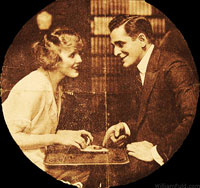 |
The Ouija Board
March 29th 1920 - May 1920 |
The Ouija Board
March 29th 1920
“The Ouija Board” was a drama/thriller that played itself out in three acts. It was produced by A. H. Woods and written by Crane Wilbur who also starred in the play. It opened in the Bijou Theatre on March 29th 1920 and ran until May of 1920. In total, there were 64 performances. Its settings were the library or Henry Annixter's house and a room in Gabriel Mogador's house in a large manufacturing town in upstate New York. The plot began around the Spiritualist Mogador who had a criminal record and was a talented forgerer. This came in handy and was a nice compliment to his automatic writing skills. Unfortunately, this medium didn't see it coming and was taken out by an automatic pistol. Enter Annixter telling his cocaine using adopted son nicknamed “snowbird” that he couldn't marry Annixter's daughter. You guessed it, bang, and no more Annixeter. Throughout the play, the Ouija board gives cryptic messages and foretells each shooting. A phonograph is enlisted to set the mood and to help with the few singing parts in this performance. Reviews at the time called “The Ouija Board an ingenious melodrama.
|








